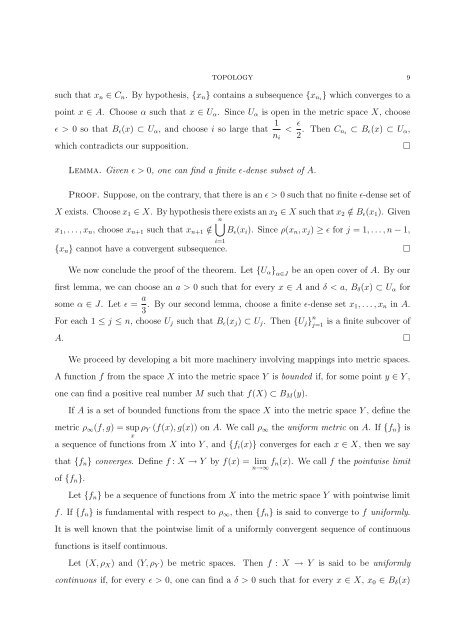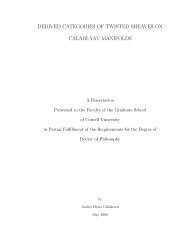FIVE MAJOR RESULTS IN ANALYSIS AND TOPOLOGY Aaron ...
FIVE MAJOR RESULTS IN ANALYSIS AND TOPOLOGY Aaron ...
FIVE MAJOR RESULTS IN ANALYSIS AND TOPOLOGY Aaron ...
Create successful ePaper yourself
Turn your PDF publications into a flip-book with our unique Google optimized e-Paper software.
<strong>TOPOLOGY</strong> 9<br />
such that xn ∈ Cn. By hypothesis, {xn} contains a subsequence {xni } which converges to a<br />
point x ∈ A. Choose α such that x ∈ Uα. Since Uα is open in the metric space X, choose<br />
ǫ > 0 so that Bǫ(x) ⊂ Uα, and choose i so large that 1<br />
ni<br />
< ǫ<br />
2 . Then Cni ⊂ Bǫ(x) ⊂ Uα,<br />
which contradicts our supposition. <br />
Lemma. Given ǫ > 0, one can find a finite ǫ-dense subset of A.<br />
Proof. Suppose, on the contrary, that there is an ǫ > 0 such that no finite ǫ-dense set of<br />
X exists. Choose x1 ∈ X. By hypothesis there exists an x2 ∈ X such that x2 /∈ Bǫ(x1). Given<br />
n<br />
x1,...,xn, choose xn+1 such that xn+1 /∈ Bǫ(xi). Since ρ(xn,xj) ≥ ǫ for j = 1,...,n − 1,<br />
i=1<br />
{xn} cannot have a convergent subsequence. <br />
We now conclude the proof of the theorem. Let {Uα} α∈J be an open cover of A. By our<br />
first lemma, we can choose an a > 0 such that for every x ∈ A and δ < a, Bδ(x) ⊂ Uα for<br />
some α ∈ J. Let ǫ = a<br />
3 . By our second lemma, choose a finite ǫ-dense set x1,...,xn in A.<br />
For each 1 ≤ j ≤ n, choose Uj such that Bǫ(xj) ⊂ Uj. Then {Uj} n<br />
j=1<br />
is a finite subcover of<br />
A. <br />
We proceed by developing a bit more machinery involving mappings into metric spaces.<br />
A function f from the space X into the metric space Y is bounded if, for some point y ∈ Y ,<br />
one can find a positive real number M such that f(X) ⊂ BM(y).<br />
If A is a set of bounded functions from the space X into the metric space Y , define the<br />
metric ρ∞(f,g) = supρY<br />
(f(x),g(x)) on A. We call ρ∞ the uniform metric on A. If {fn} is<br />
x<br />
a sequence of functions from X into Y , and {fi(x)} converges for each x ∈ X, then we say<br />
that {fn} converges. Define f : X → Y by f(x) = lim<br />
n→∞ fn(x). We call f the pointwise limit<br />
of {fn}.<br />
Let {fn} be a sequence of functions from X into the metric space Y with pointwise limit<br />
f. If {fn} is fundamental with respect to ρ∞, then {fn} is said to converge to f uniformly.<br />
It is well known that the pointwise limit of a uniformly convergent sequence of continuous<br />
functions is itself continuous.<br />
Let (X,ρX) and (Y,ρY ) be metric spaces. Then f : X → Y is said to be uniformly<br />
continuous if, for every ǫ > 0, one can find a δ > 0 such that for every x ∈ X, x0 ∈ Bδ(x)
















